
Grand delusions.Illustration: Chen Xia/GT
भारतीय रोज़ न्यूज़ भारत की सबसे अधिकारपूर्ण, समय पर और विश्वसनीय समाचार सलाहकार वेबसाइट है

Grand delusions.Illustration: Chen Xia/GT
AIM Congress 2024, a premier global investment platform, kicked off today in Abu Dhabi under the theme “Adapting to a Shifting Investment Landscape: Harnessing New Potential for Global Economic Development”.
Set to take place until 9th May, AIM Congress 2024 boasts an impressive lineup of participants, including over 100 ministers, city mayors and central bank governors; 900 speakers; 11 global stock markets; 50 unicorn companies; and more than 12,000 delegates representing 175 countries worldwide. They will participate in 27 joint events organised in cooperation with more than 330 local, regional, and international partners.
AIM Congress is an initiative of the AIM Global Foundation and is organised with the support of the Ministry of Industry and Advanced Technology and the Abu Dhabi Department of Economic Development.
The current edition of the summit, held at the Abu Dhabi National Exhibition Centre (ADNEC), offers numerous opportunities for investors, businessmen, and investment companies from around the world to network and explore specialised investment projects across various sectors, featuring 450 dialogue sessions and seven high-level roundtable meetings.

Illustration: Liu Xiangya/GT
The construction of the Hungary-Serbia railway, a flagship project of the China-proposed Belt and Road initiative (BRI), will help inject new impetus into the economies of the two countries. The railway, plus the China-Serbia Free Trade Agreement (FTA) signed in 2023, may provide people with a new perspective on the increasingly fragmented global trade situation.
As reported by the Xinhua News Agency on Sunday, Serbia’s Minister of Construction, Transport and Infrastructure Goran Vesic said that Serbia’s participation in the BRI has boosted the overall development of the country and its neighbors. He cited the construction of the Hungary-Serbia railway as an example of successful BRI cooperation.
The Hungary-Serbia railway is a double-track electrified railway with a total length of 341.7 kilometers, including 183.1 kilometers in Serbia. Sitting at the crossroads of Central and Southern Europe – and often seen as a geographical region that straddles both Eastern and Western Europe – Serbia has unique geographical advantages. The construction of the railway is expected to improve connectivity between Hungary and Serbia and help clear barriers from Serbia to Greece’s Piraeus Port, a transit hub connecting Europe, Asia and Africa.
The Hungary-Serbia railway is considered an important project to improve physical connectivity, as part of multifaceted cooperation aimed at deepening economic exchanges.
Connectivity includes not only physical infrastructure like roads and railways but also institutional arrangements to make it easier to strengthen exchanges among different regions.
China and Serbia signed an FTA in October 2023. The signing of the FTA and subsequent tariff cuts have enhanced trade relations, boosted Serbia’s exports and – more importantly – served as a bridge to open up new trade routes and ramp up trade and investment between China and Europe.
Trade between China and Europe reached $1.215 trillion in 2023. Both sides have strong trade complementarity, and unleashing this potential can generate more positive influences on Europe’s economy, helping solve problems it faces, such as stubborn inflation.
The lingering question is how to unleash this huge potential. There are two critical factors. On the one hand, we should continue to promote infrastructure interconnectivity; on the other hand, we should take concrete actions to reject all forms of protectionism and unequivocally advocate for and support free trade.
Facing a complex and volatile international situation, China and Serbia, acting as each other’s “ironclad friends,” have continuously enhanced cooperation in multiple fields such as railway infrastructure construction and free trade. These factors interact with one another, forming a joint force to boost economic cooperation.
The nature of cooperation is mutually beneficial, and that’s why the Serbian side holds a positive attitude toward cooperation with China. Vesic said Serbia is proud of its participation in the BRI, under which Chinese companies have undertaken many infrastructure projects in the country.
The construction of the Hungary-Serbia railway reached a milestone on April 25, when the track-laying work for a 108-kilometer section between Novi Sad and Subotica in Serbia was completed. It’s not always easy to undertake large-scale infrastructure projects, and the construction of the Hungary-Serbia railway faces some challenges, but the project has been steadily advancing. That’s because this is good for the Serbian economy, which could benefit greatly from infrastructure projects.
Amid global economic uncertainty, various countries, including those in Europe, are trying to gain new growth momentum as traditional drivers weaken. What is needed today is to improve economic connectivity and further promote free trade. As long as cooperation can bring tangible economic benefits to local economies, it will eventually overcome temporary challenges and difficulties.
The US-advocated “decoupling” and Washington’s geopolitical games have brought enormous challenges to global trade, but globalization and free trade are the only ways to promote mutually beneficial cooperation. Politicians with a sober mind will not politicize economic issues and not fall into the “decoupling from China” trap.
The author is a reporter with the Global Times. [email protected]
01:25

China’s Chang’e-6 lunar probe aims to land in the historically rich Apollo Craters region on the far side of the moon. Giuseppe Reibaldi, president of the Moon Village Association, speaking with CGTN, identified several technological hurdles associated with the mission. Chief among these is establishing reliable communication with the spacecraft while it operates on the far side of the moon. The target landing region’s varied altitude changes and rugged terrain increase the difficulty of launching from the lunar surface. But the area is “important” to understand the moon’s evolution, he said. Check out the video to learn more!
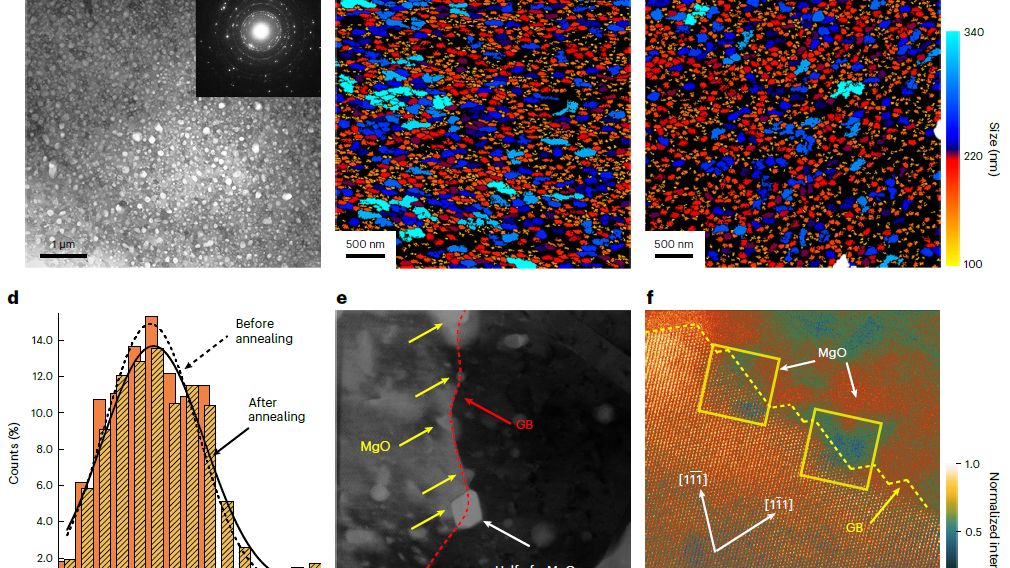 An illustration shows the novel high-strength aluminum alloy demonstrating exceptional resistance to high temperatures. /Tianjin University
An illustration shows the novel high-strength aluminum alloy demonstrating exceptional resistance to high temperatures. /Tianjin University
An illustration shows the novel high-strength aluminum alloy demonstrating exceptional resistance to high temperatures. /Tianjin University
A team of Chinese scientists has developed a high-strength aluminum alloy that remains operational even at 500 degrees Celsius.
This advancement has extended the service temperature range of aluminum alloys from 350 to over 400 degrees Celsius, addressing a long-standing engineering challenge.
The demands of the aerospace industry have set higher standards for thermal resistance in lightweight metal materials.
This innovative process is characterized by its simplicity, minimal material costs and scalability, making it highly valuable for industrial applications, said He Chunnian from Tianjin University, the corresponding author of the paper.
Although aluminum alloys are favored for their low density, high strength and robust corrosion resistance, their relatively low heat-resistance poses a considerable challenge, especially within the crucial temperature range of 350 to 500 degrees Celsius, which is pivotal for aerospace applications.
Researchers at Tianjin University synthesized aluminum alloys embedded with highly dispersive nanoparticles. The nanoparticles have grown in-situ graphene-like coatings, which significantly contribute to a reduction in surface energy.
Thanks to the incorporation of these nanoparticles, the alloys exhibit exceptional creep resistance at elevated temperatures of up to 500 degrees Celsius, according to the study published recently in the journal Nature Materials.
They also boast an impressive tensile strength of approximately 200 megapascals at that temperature, about six times higher than ordinary aluminum alloys.
(With input from Xinhua)
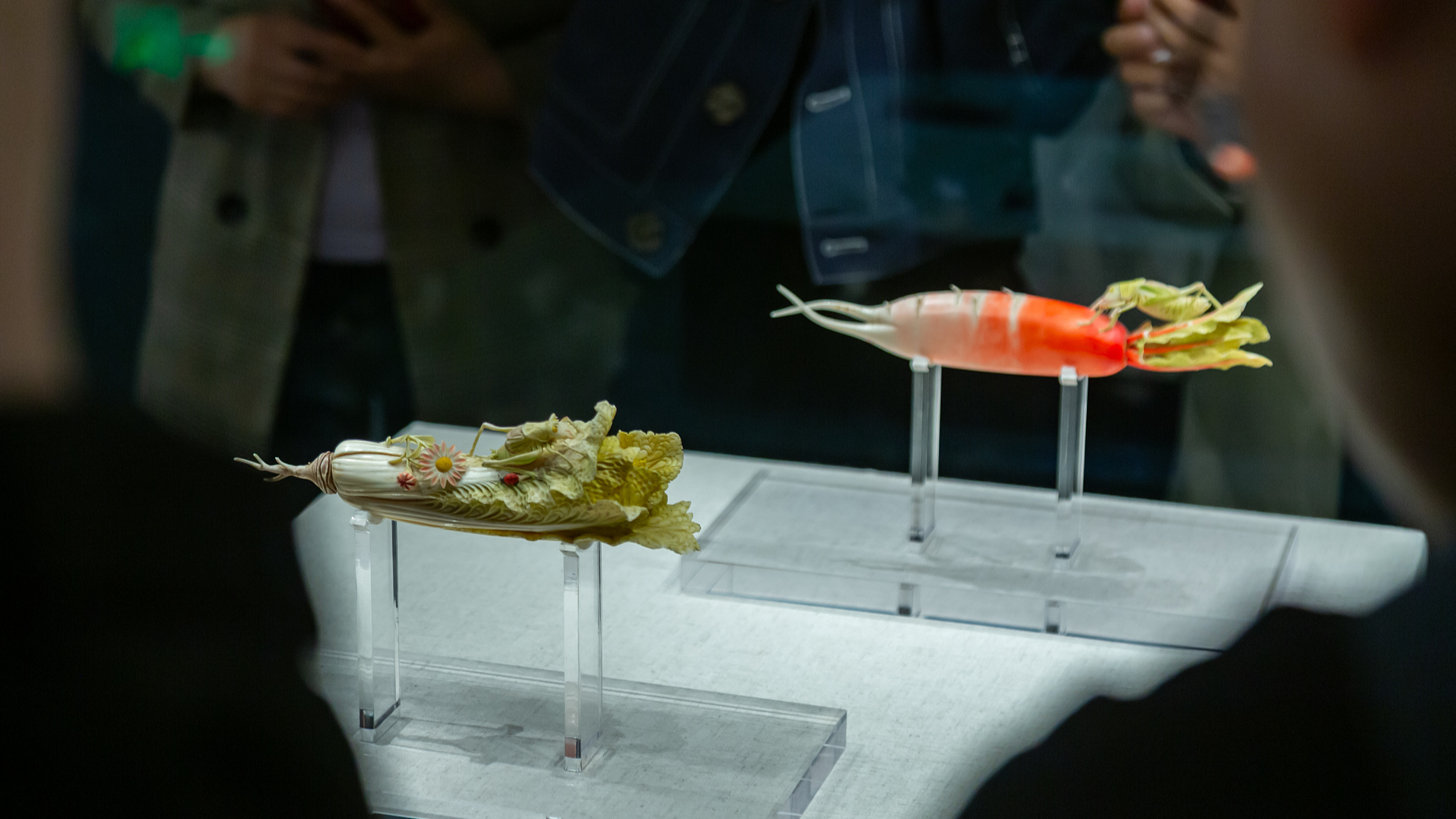 A photo taken on May 5, 2024 shows people appreciating ivory radish and cabbage on display at Henan Museum in Zhengzhou, Henan Province, China. /CFP
A photo taken on May 5, 2024 shows people appreciating ivory radish and cabbage on display at Henan Museum in Zhengzhou, Henan Province, China. /CFP
A photo taken on May 5, 2024 shows people appreciating ivory radish and cabbage on display at Henan Museum in Zhengzhou, Henan Province, China. /CFP
During the recently concluded May Day holiday, museums remained a hot destination. Henan, known as a province rich in cultural relics, has unearthed countless national treasures. Among the 130,000 artifacts housed in the Henan Museum, a pair of radish and cabbage sculptures stood out as one of the museum’s top 10 treasures.
As soon as the museum opened its doors, visitors flocked straight to the exhibition hall, equipped with professional cameras, eager to capture their favorite star exhibits. What kind of radish and cabbage could withstand the test of centuries and still look so “fresh and tender?”
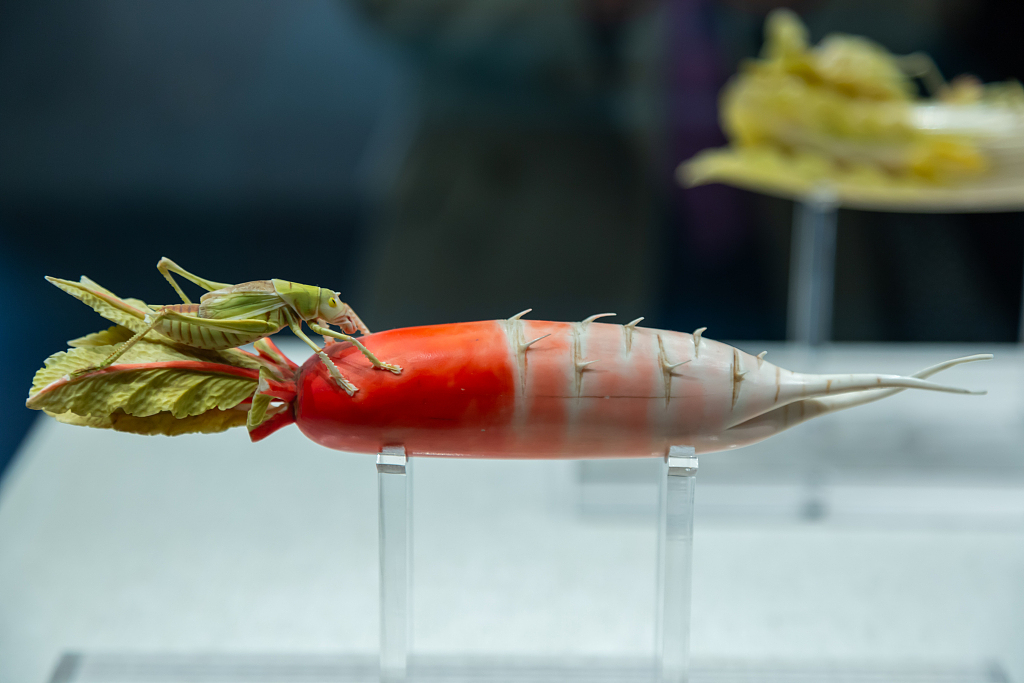 A photo taken on May 5, 2024 shows a closer look at the ivory radish on display at Henan Museum in Zhengzhou, Henan Province, China. /CFP
A photo taken on May 5, 2024 shows a closer look at the ivory radish on display at Henan Museum in Zhengzhou, Henan Province, China. /CFP
A photo taken on May 5, 2024 shows a closer look at the ivory radish on display at Henan Museum in Zhengzhou, Henan Province, China. /CFP
This is a pair of radish and cabbage carvings made of ivory during the Qianlong period of the Qing Dynasty (1644-1911). The ivory radish is about 27 centimeters long and weighs 229 grams. Its root gradually changes from red at the top to pink in the middle and white at the base, with naturally curved roots. The green leaves, with their main veins dyed red, exude a sense of movement as a grasshopper extends its front legs from the radish leaves toward the stem, eagerly seeking the sweet juice.
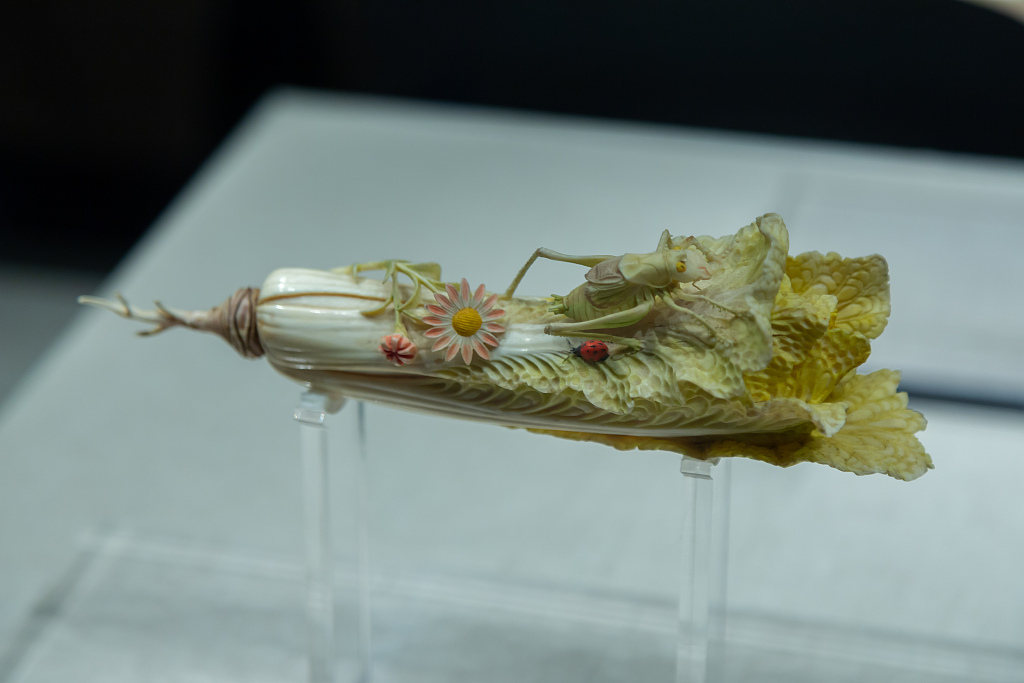 A photo taken on May 5, 2024 shows a closer look at the ivory cabbage on displayed at Henan Museum in Zhengzhou, Henan Province, China. /CFP
A photo taken on May 5, 2024 shows a closer look at the ivory cabbage on displayed at Henan Museum in Zhengzhou, Henan Province, China. /CFP
A photo taken on May 5, 2024 shows a closer look at the ivory cabbage on displayed at Henan Museum in Zhengzhou, Henan Province, China. /CFP
About 23 centimeters long and weighing 260 grams, the ivory cabbage shows layers of its white stem, green leaves, yellow heart and brown roots with clear veins. Two small flowers adorn the stem, one budding and the other in full bloom. A grasshopper rests on the back of the cabbage, blending seamlessly with the green leaves as it savors the fresh juice. Next to it lies a ladybug, its antennae barely visible, seemingly absorbed in its own feast.
The homophony of “cabbage” and “radish” in Chinese conveys the auspicious notions of continued prosperity and progress. In Chinese culture, grasshoppers symbolize family prosperity and longevity due to their strong reproductive abilities. So, the themes of “radish,” “cabbage,” and “grasshoppers” were common in art during the Ming (1368-1644) and Qing (1644-1911) dynasties, signifying auspiciousness through imagery.
These ivory radish and cabbage exhibits not only showcase the craftsmanship of ancient artisans but also reveals the profound symbolism of auspiciousness in traditional Chinese culture.
Cultural exchanges between China and other countries are booming, with an increasing number of visiting international exhibitions. As part of our “Art Without Boundaries” series, our reporter Wang Siwen talks to Miguel Falomir Faus, the director of the Spanish national art museum, the Museo Nacional del Prado, which has just brought its largest collection to China.
07:42
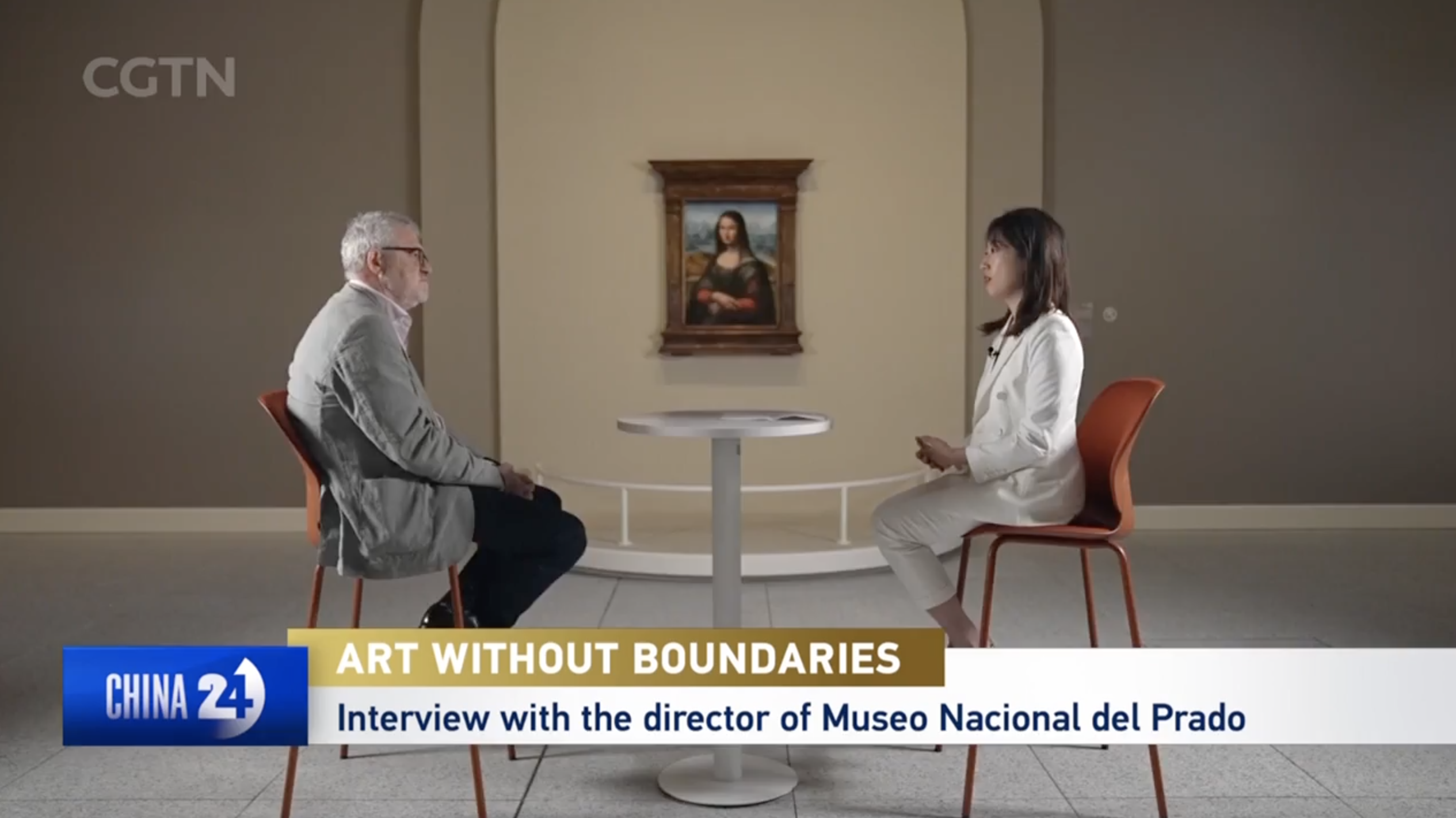
Reporter: This is the first cooperation arrangement between the Prado Museum in Madrid and the Museum of Art Pudong. This exhibition showcases a mix of Chinese and Western cultures. So, why choose Shanghai for this exhibition?
Faus: It’s important to be here. It’s important to show to the Chinese public, the paintings that we have in the Prado. We have had growing numbers of Chinese visitors every year. So for us, it’s quite important to be part of the vibrant artistic scene that we see in this city.
Reporter: Contact between China and Spain can be traced back to the Ming Dynasty, when Diego de Pantoja met Emperor Wanli in 1601. What kind of chemistry happens when two different cultures, from East and West, meet each other?
Faus: Actually, contact started before Pantoja, when the Spaniards arrived in the Philippines in the 1560s from Mexico, and the relationship between China and Spain started then. There were many differences – political differences, cultural differences, religious differences – but there were also points in common. In the end, for human beings, it doesn’t matter where and when we share, there is always fear, passion, and love. That’s the point, and what allows communication between different cultures.
Reporter: The Prado Museum is very active on social media, and it clearly has a digital strategy. On TikTok, the museum has nearly 600,000 followers. What results have you seen after making the Prado collection accessible online?
Faus: We are the museum with the most followers in TikTok in the world, double our nearest rival. I remember the first day that the person in charge of social media came to my office and told me about a new a social media platform called TikTok, which he thought might be interesting for us to use. The only problem was that they’re very short. I remember my answer. If you are able to encapsulate something of interest in 60 seconds, then go ahead. He did. And since then, he has proved to everyone that you can convey very interesting subjects within a very short period of time. It’s an amazing way to get in touch, mostly with the younger audience. Our public is becoming younger and younger, in many ways thanks to TikTok.
We have also worked with some Chinese social media platforms and some influencers from China. We have had a lot of success in doing so in the past.
Reporter: Spain has many museums but the Prado, which opened in 1819, is one of the most popular, with three million visitors per year, and over half of them overseas tourists. How do you make sure it remains attractive after so many years?
Faus: What makes the Prado different from other museums of Western art is the fact that it is the former royal collection, so it’s not a museum created or designed by scholars like so many others. The kings and queens of Spain in the past, they just collected what they like, they didn’t collect what they didn’t like. So that explains why the Prado Museum has been called “a museum of painters” rather than of paintings, because we have the largest collections of paintings by Bose, by Raphael, by Rubens, by Velazquez, by Goya. That provides the public with an immersive experience that you can’t find in any other museum.
Reporter: Internationally, how can museums draw more visitors?
Faus: Big museums serve three purposes – they are international institutions, they are national institutions, and they are local institutions. So, we have to see how to satisfy these three different audiences. It’s not always easy to make it compatible to all these different kinds of visitors. I think this is a challenge that all big museums are facing in the world.
Reporter: It is said you had twice rejected the opportunity to be the director of the Prado Museum before you took up the role in 2017. What made you change your mind?
Faus: I studied the history of art. I like to think of myself as a scholar devoted to Italian Renaissance art. In the end, I accepted the role just because I love the Prado. I couldn’t see myself directing any other museum. I have a professional and personal commitment to the institution.
Reporter: You are a curator, a scholar, a person who loves and knows art, in particular Italian Renaissance paintings. What’s your mission as the director?
Faus: The paintings are there, and the paintings are always the same. It’s society that’s changing. My main concern is how to answer the question why the Prado still matters, trying to provide our visitors with the tools to understand why the Prado is important, and why it is one of the most important collections of Western art in the world. That’s my main task.
Reporter: You once said, and I quote: “After hundreds of years, the empire was swept away and the only thing left is the Prado.” What’s so unique about the Prado? What personal bond do you share with the museum?
Faus: Spain right now is a small country. It’s not among the most powerful countries in the world as it was centuries ago. When you see all the richness and power, the glory – it’s all gone. In the end, what remains? It’s the art. That’s why through the collections at the Prado, you can learn about the history of Spain. One of the most distinctive features of the Prado is how closely it is connected with the history of Spain. I think that’s what we are doing with this exhibition in a very successful way.
Reporter: And lastly, I know it’s probably impossible, but I still need to ask – is there any chance we will be able to see (1656 Velázquez painting) “Las Meninas” in China?
Faus: Sadly, I have to say that it’s not going to be possible. It’s one of the very few paintings that cannot leave the Prado. There is also a list of paintings that due to their fragility or their importance cannot leave the Prado. “Las Meninas” is at the top of that list. It’s our most treasured painting, and the most iconic work that we have. It’s also a very large painting and not easy to move. But that provides people from Shanghai with a good reason for visiting us in Madrid.
00:42
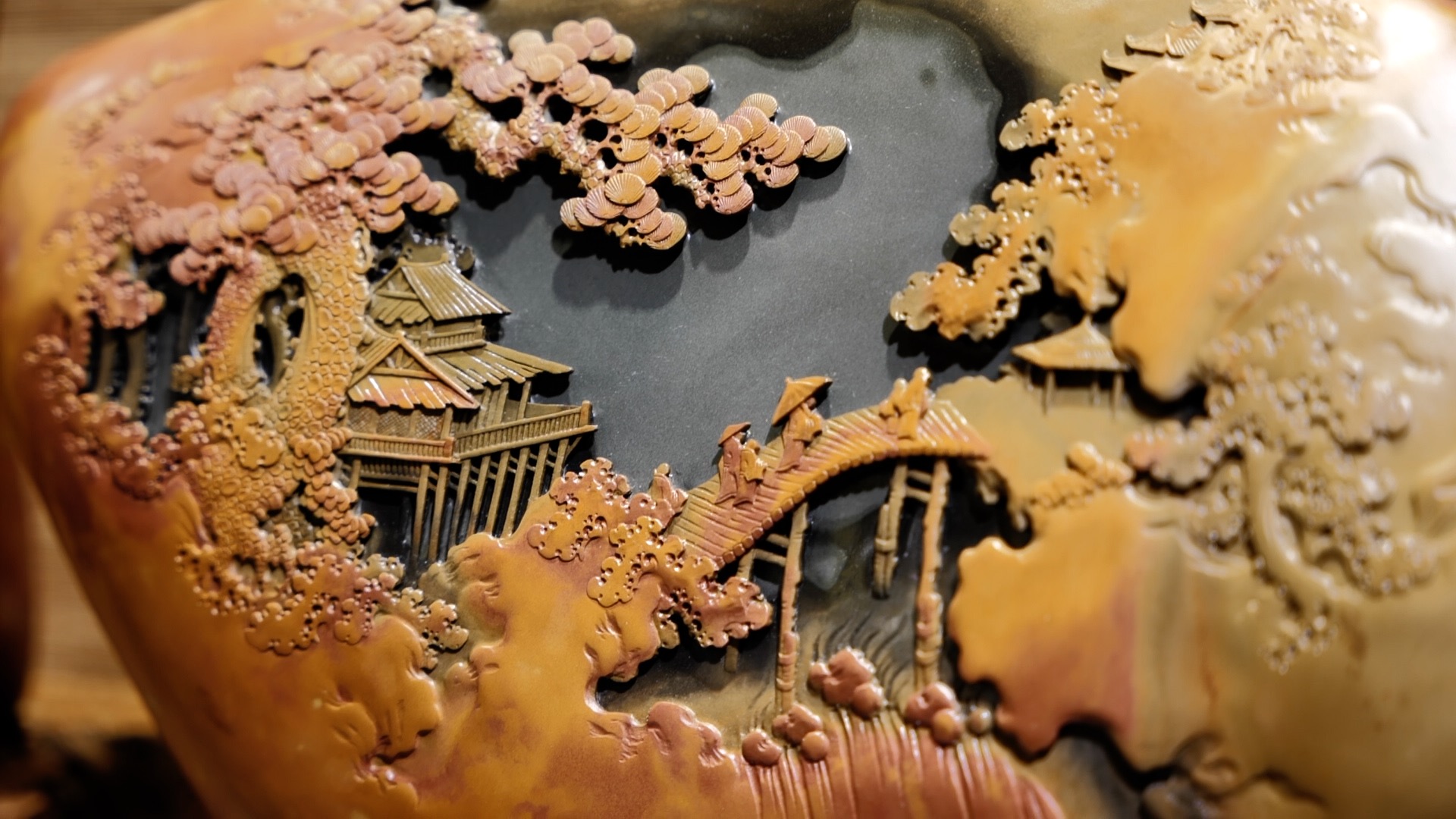
The “Four Treasures of Study,” namely a writing brush, ink stick, paper and ink slab, were highly sought after by ancient Chinese scholars. Today, ink slab artisans are better known for their ingenuity and skills in combining this particular craft with tearoom decorations. Let’s take a closer look at these innovative tearoom adornments.
02:42
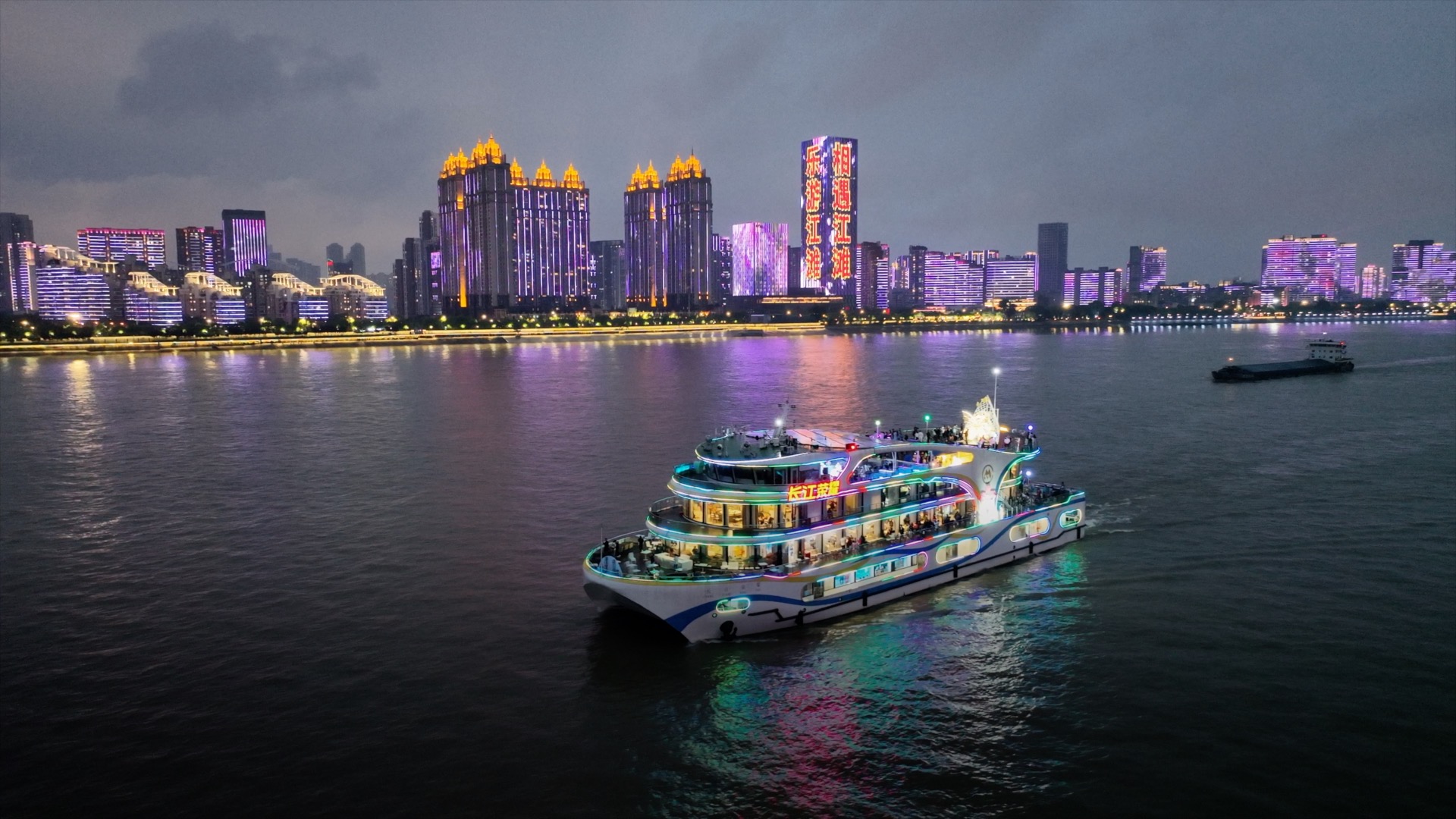
Passenger ships along the Yangtze River in Hubei Province once catered to commuters. However, the industry has now innovated itself by embracing environmental sustainability while offering quality services. CGTN’s Huang Yichang goes on board in Wuhan.
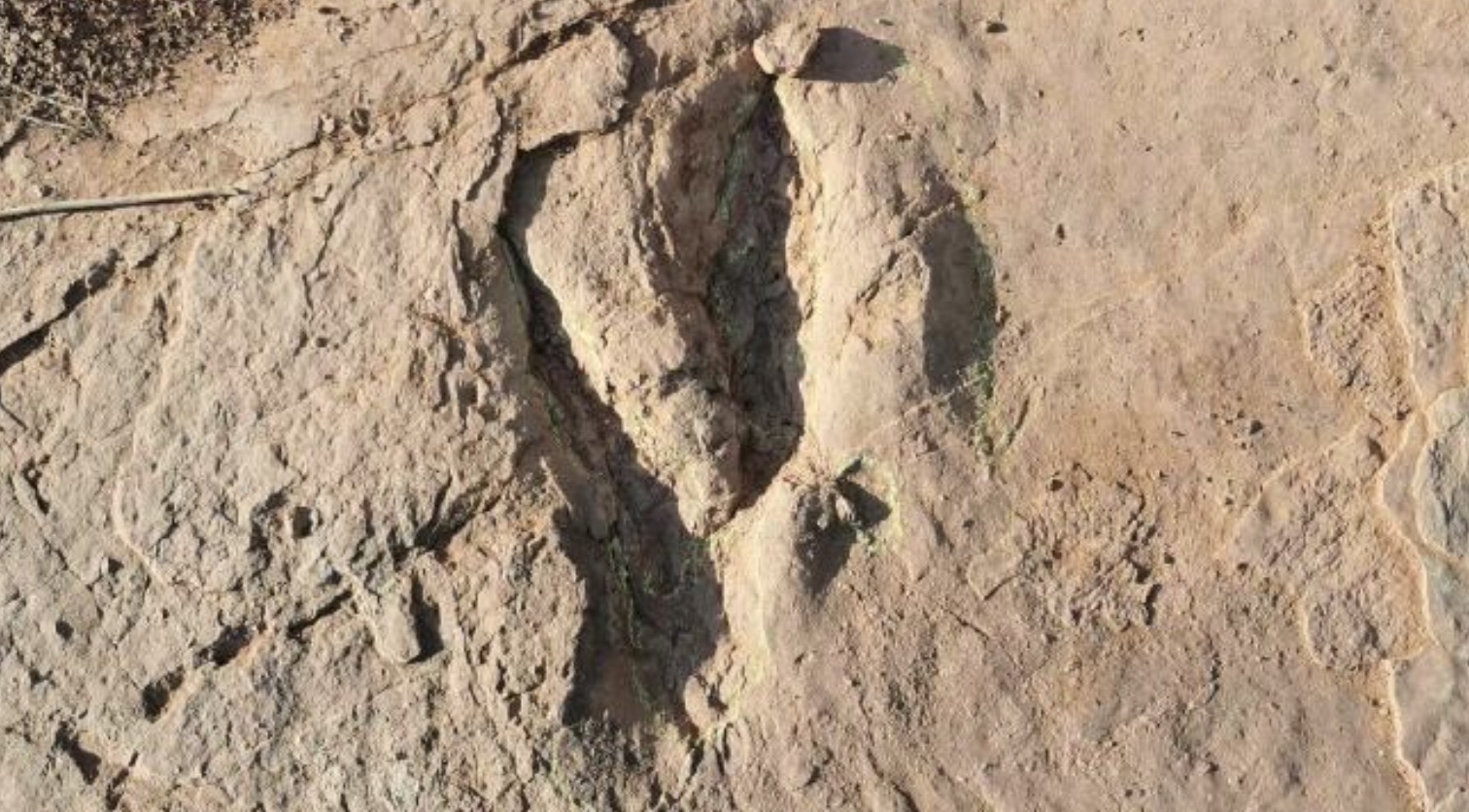 A dinosaur tracksite discovered in Lincheng Town, Longyan City, southeast China’s Fujian Province. /CMG
A dinosaur tracksite discovered in Lincheng Town, Longyan City, southeast China’s Fujian Province. /CMG
A dinosaur tracksite discovered in Lincheng Town, Longyan City, southeast China’s Fujian Province. /CMG
A team of scientists on Monday claimed discovering large two-toed tracks of deinonychosaurs in Lincheng Town, southeast China’s Fujian Province.
At least eight types of dinosaur tracks have been found over the years at the Longxiang tracksite by scientists and experts from China University of Geosciences and Yingliang Stone Natural History Museum, 12 of which are didactyl deinonychosaur tracks that fall into two morphologies.
Among the 12 two-toed fossil tracks, five large tracks measuring 36.4 centimeters in length and 16.9 centimeters in width, on average, led researchers to establish a new dinosaur taxon: Fujianipus yingliangi.
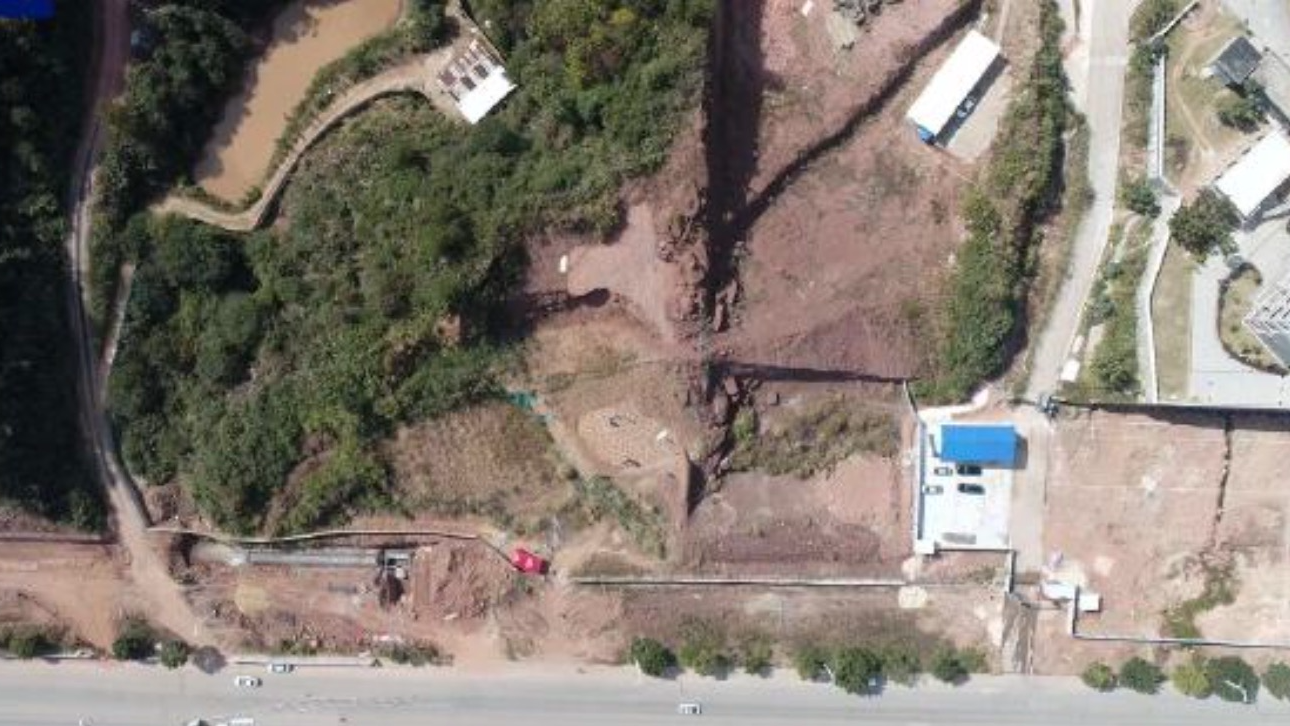 A dinosaur tracksite discovered in Lincheng Town, Longyan City, southeast China’s Fujian Province. /CMG
A dinosaur tracksite discovered in Lincheng Town, Longyan City, southeast China’s Fujian Province. /CMG
A dinosaur tracksite discovered in Lincheng Town, Longyan City, southeast China’s Fujian Province. /CMG
Based on relative toe proportions, Fujianipus is a probable troodontid.
“These are currently the largest deinonychosaur tracks found in China and beyond,” said Xing Lida, an associate professor at China University of Geosciences, adding that based on the size of the tracks, it is estimated that Fujianipus was at least 5 meters long, with a hip height of nearly 2 meters.
“The Longxian tracksite is the best-preserved, largest area and the most diverse Late Cretaceous dinosaur tracksite discovered in China to date,” said Niu Kecheng, curator of Yingliang Stone Natural History Museum.
The discovery of the Fujianipus yingliangi greatly expands the size range of deinonychosaur tracks, which is of great significance for the study of the Late Cretaceous dinosaurs in China, Niu added.
The discovery was recently published in the international journal iScience.
Source(s): Xinhua News Agency